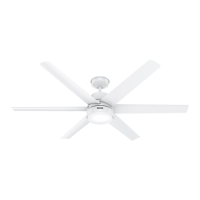5
6
S
l
i
d
e
c
a
n
o
p
y
o
v
e
r
d
o
w
n
r
o
d
a
n
d
w
i
r
e
s
.
Place the downrod ball into
the slot in the ceiling bracket.
To prevent damage to fan,
ALWAYS lift holding either the
fan housing or the downrod.
Ceiling Bracket Downrod Hanging Fan Wiring Canopy Blades Light ControlGlass
S
l
i
d
e
c
a
n
o
p
y
o
v
e
r
d
o
w
n
r
o
d
a
n
d
w
i
r
e
s
.
Place the downrod ball into
the slot in the ceiling bracket.
To prevent damage to fan,
ALWAYS lift holding either the
fan housing or the downrod.
Follow below if you are using the downrod that came pre-assembled in your box. Need to
install a longer or shorter downrod? Check out the guide at the end of this manual.
Slide the adapter cover onto
the downrod until it rests
against the hanger ball.
Pass all wires to one side of horizontal bar in
downrod assembly. Hand tighten the downrod
(at least 4–5 full turns) until it stops. Trim the
wires coming from the fan so that 8-inches
remain coming from the top of the downrod.
Hunter Pro Tip:
The ground wire attached to the
downrod is approximately 8 inches.
Hunter Pro Tip:
The adapter cover is not used for
low-pro le mounting.
Tighten the setscrew
with pliers. DO NOT
HAND TIGHTEN.
FAN FALL HAZARD
To prevent SERIOUS INJURY or DEATH:
• ALWAYS
tighten setscrew with pliers.
• DO NOT
hand tighten setscrew.
• CHECK
the setscrew is tight using pliers
each time you change fan direction.
Lower the adapter cover until it rests ush
against the motor housing.
Fan style may vary.
Note:
K
E
E
P
!
Back out the pre-installed setscrew
so that the setscrew’s threads
are still engaged while the shank
does not protrude and obstruct the
insertion of the downrod.
DO NOT
REMOVE
SETSCREW
COMPLETELY
8”
3/8”
C
U
T
&
S
T
R
I
P
(not to scale)
We know wiring is hard. Let’s make it easier.
You are going to need these:
4 Wire Nuts (these are in the
bag)
Follow these steps to get your fan wired quickly and safely. Follow the route below that best matches your wall switch
setup. If you are unfamiliar with wiring or uncomfortable doing it yourself, please contact a quali ed electrician.
Have a single switch?
Follow these steps:
Have dual switches?
Follow these steps:
Hunter Pro Tip:
Here is how to connect the wires:
Push the bare metal ends of the wires together and slide a wire
nut over them. Then, twist the wire nut clockwise until tight.
Give it a gentle pull to make sure none of the wires are loose.
Connect the white
(grounded) wire
from the ceiling
to the white wire
from the fan.
Connect the second ungrounded
(light) wire from the ceiling to
the blue wire from the fan.
Connect the three
grounding wires (green,
green/yellow stripe, or
bare copper) coming from
the ceiling, downrod, and
hanging bracket.
Connect the black (live)
wire from the ceiling to
the black wire from the
fan.
Blue
Black
Black
Blue
Black
Green/Yellow Stripe
Green/Yellow Stripe
White
White
Live
Live
Ungrounded (light)
Grounded
Grounded
Grounding
Grounding
G
r
e
e
n
/
Y
e
l
l
o
w
S
t
r
i
p
e
G
r
e
e
n
/
Y
e
l
l
o
w
S
t
r
i
p
e
x4
bag
x4
bag
Wire Nut
Wire Nut
All wiring must be in accordance with
national and local electrical codes ANSI/NFPA
70. If you are unfamiliar with wiring or in
doubt, consult a quali ed electrician.
Connect the white
(grounded) wire
from the ceiling
to the white wire
from the fan.
Cap the blue wire from the
fan.
You will not need it
for single switch wiring.
Connect the black
(ungrounded) wire from
the ceiling to the black
wire from the fan.
Connect the three
grounding wires (green,
green/yellow stripe, or
bare copper) coming from
the ceiling, downrod, and
hanging bracket.
Have extra wiring?
Turn the wires upward and push them carefully back
through the hanger bracket into the outlet box. Spread
the wires apart, with the grounded wires on one side of
the outlet box and the ungrounded wires on the other
side of the outlet box. Make sure that the wires are still
attached to the wire nuts.
Hunter Pro Tip:
WETDRSKY-01 r081222
The ceiling fan must be grounded. If the
ground wire for the installation site is not
present, immediately STOP installation and
consult a quali ed electrician.
Fan style may vary.
Note:

